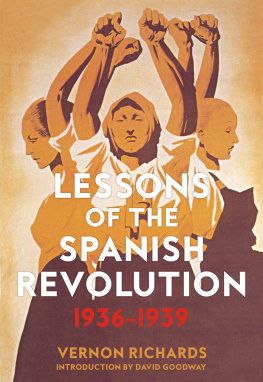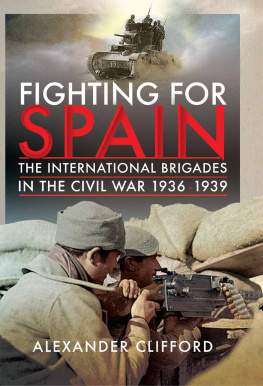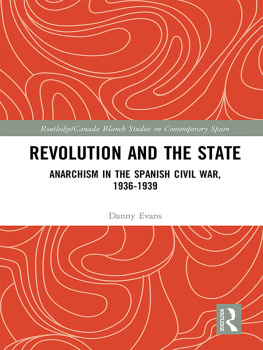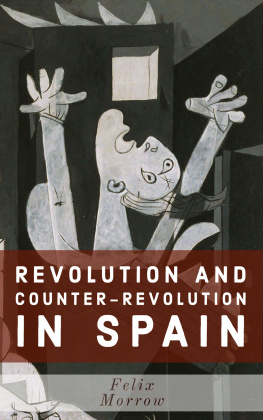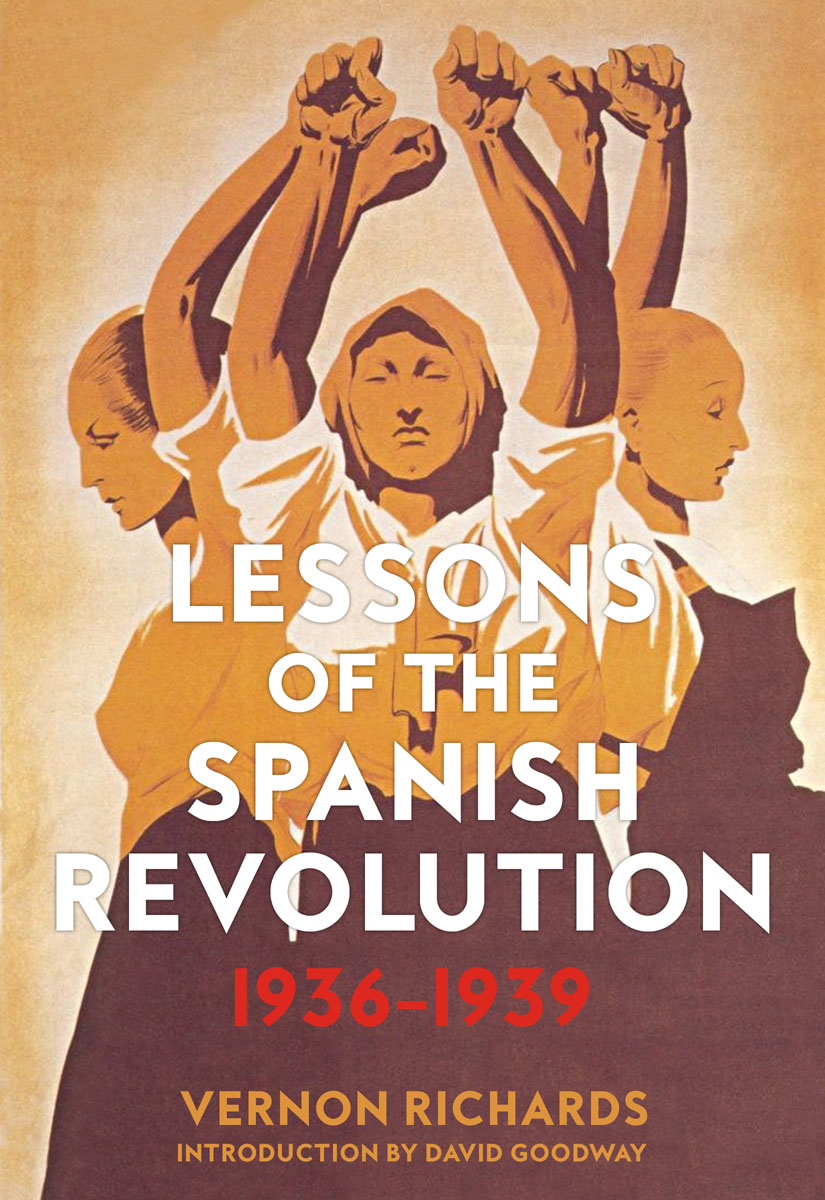
Lessons of the Spanish Revolution: 19361939
Vernon Richards
This edition 2019 PM Press
All rights reserved. No part of this book may be transmitted by any means without permission in writing from the publisher.
ISBN: 978-1-62963-647-4
Library of Congress Control Number: 2018949093
Cover by John Yates / www.stealworks.com
10 9 8 7 6 5 4 3 2 1
PM Press
PO Box 23912
Oakland, CA 94623
www.pmpress.org
Printed in the USA
Publishers Note
This book began as a series of twenty-three weekly articles for the anarchist journal Freedom (JulyDecember 1952). They were reprinted in volume form with an introduction (July 1953). A Japanese translation appeared the following year.
For an Italian edition in 1957 the author produced a considerably expanded version. Part I remained unchanged apart from minor corrections and some additions. Part II was all new material except for chapter 18 and the first part of the conclusions. A Spanish edition was published in Paris (Bellibaste, 1971).
For the second Freedom Press edition (1972) a bibliographical postscript was added to the Italian edition. This version has since been published in French (Paris: Editions 10/18, 1975), Italian (Pistoia: Edizioni V. Vallera, 1974) and Spanish (Madrid: Campo Abierto Ediciones, 1977 [reprinted 1978]).
For the third Freedom Press edition (1983) the author added footnotes to a bibliographical postscript and also reprinted from Freedom (January 1978) a review of the third edition of Hugh Thomass The Spanish Civil War.
This, the 2019 PM Press edition of Vernon Richardss classic analysis of the Spanish Civil War, is largely a reprint of the Freedom Press 1983 edition, with certain modernizations to spelling, hyphenation, capitalization, and punctuation. One brief section of approximately ten pages in the previous edition was removedan overly arcane and largely redundant critique of the second edition of Hugh Thomass The Spanish Civil War, a book already critically addressed at length elsewhere in the text.
CONTENTS
INTRODUCTION
LESSONS OF THE SPANISH REVOLUTION AND VERNON RICHARDS
Lessons of the Spanish Revolution originated as twenty-three weekly articles published in Freedom between July and December 1952. In July 1953, these were reprinted as a book. A considerably expanded version was prepared for an Italian edition of 1957; and it was this text that was published as the second Freedom Press edition in 1972. A third Freedom Press edition appeared in 1983. In its various forms it has been one of Freedom Presss most influential and bestselling publications.
Lessons is a brutal, unrelenting and entirely unforgiving critique of the CNT-FAIs decision to enter the Popular Front government in October 1936, impressive in its documentation and irrefutable in its logic. On September 3, a clear-sighted editorial in Solidaridad Obrera, the CNTs daily newspaper, had argued: The coordination of the forces of the Popular Front, of the organization of the supply of foodstuffs with an extensive collectivization of undertakings is of vital interest in achieving our objectives. It has been achieved up to now in a non-governmental, decentralized, demilitarized manner. In contrast, it foresaw:
A coalition government with its base political struggles between majorities and minorities, its bureaucratization, based on chosen elites, and the fratricidal struggles in which the opposing political factions are engaged, [would] make it impossible for such a government to benefit our work of liberation in Spain. It would lead to the rapid destruction of our capacity of action, of our will to unity and the beginning of an imminent debacle before a still fairly strong enemy.
Federica Montseny, who became one of the four anarchist ministers in the Madrid government, consulted her father, the veteran anarchist intellectual Federico Urales, before reaching her decision, and he had warned:
You know what this means. In fact, it is the liquidation of anarchism of the CNT. Once in power you will not rid yourselves of Power.
Richards argues that the libertarian leadership made two fundamental errors, inexcusable since they were not errors of judgment but a deliberate abandonment of their principles. First was their belief that the war against authority could be waged more successfully within the framework of the state and by subordinating all else, including economic and social transformation, to winning the war. Second was their naive conviction that it was essential, and possible, to collaborate with political partiesthat is with politicianshonestly and sincerely, and this at a time when real power belonged to the CNT-FAI and the socialist UGT. As Montseny was to confess: in politics we were quite ingenuous. From the outset the professional politicians ran rings around the libertarians, who were outwitted and outmanoeuvred on every issue. And whereas contact with the libertarians had no ideological impact on the politicians, some leading members of the CNT were converted to the principles of government and centralized authority, not just temporarily but permanently.
For Richards, the May Days of 1937 in Barcelona equate with Kronstadt in Russia in 1921, marking the suppression of the popular movement as it attempted to resuscitate the revolution. He concludes: With the defeat of the revolution in May 1937 by the central authority the leaders of the CNT-FAI no longer represented a force to be reckoned with by the government, which proceeded to take over the militias, abolish the workers patrols in the rearguard, and smash the collectives, thus pulling the teeth of the revolution; and it was left to the leaders of the CNT to break its heart.
Richards further considers that libertarians were misguided in voting for the Popular Front parties in the general election of February 1936. In 1933, the left had been routed in the first election under the new constitution of the Second Spanish Republic, largely on account of anarchist abstention. In consequence the Bieno Negro (Two Black Years) of reactionary rule followed, amassing thirty-three thousand political prisoners. The second No Votar! (Do Not Vote!) campaign was therefore half-hearted, and the Popular Front was able to form a government. Yet its victory was a disaster, Richards argues, since an effective military uprising now became inevitable. In contrast, had the right won, military conspiracy would have petered out. He insists, very salutarily given the customary loose language employed about fascism, that there is no real evidence to show that there was any significant development of a fascist movement in Spain along the lines of the regimes in Italy and Germany.
Richards also believes the CNT was remiss in making no attempt to seize the Spanish gold reserve, the second largest in the world. In the summer of 1936, the immediate need was for raw materials and arms. Catalonia was Spains principal industrial and military centre, yet it was starved of funds by the Madrid government. For Catalan workers to produce arms it was necessary to re-equip and retool factories: the requisite machinery had to be bought abroad. Aircraft, motorized transport, rifles, guns, and ammunition also needed to be acquired outside of Spainand for gold anything was available and from whatever source. Madrids objection was that the war industry in Catalonia was controlled by its workers; and the CNTs response was pusillanimous.

Next page
